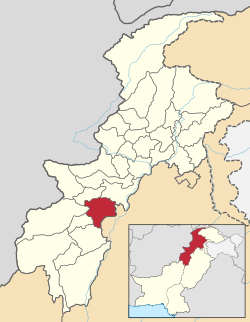Karak (district)
| Karak district | |
| State : |
|
| Province : | Khyber Pakhtunkhwa |
| Seat : | Karak |
| Coordinates : | 33 ° 8 ' N , 71 ° 5' E |
| Area : | 3 372 km² |
| Residents : | 706,299 (2017) |
| Population density : | 209 inhabitants per km² |
| Time zone : | PST ( UTC + 5 ) |

|
|
Karak District is an administrative district in Pakistan in Khyber Pakhtunkhwa Province . The seat of the district administration is the city of the same name Karak .
The district has an area of 3372 km² and according to the 2017 census 706,299 inhabitants. The population density is 209 inhabitants / km².
geography
The district is located in the south of the Khyber Pakhtunkhwa Province, which is in the north of Pakistan. The district has significant natural resources. The salt mines have been known since ancient times and were an important source of salt for the Indian subcontinent until the British era. More recently, petroleum, gas, and uranium have been discovered.
history
The district was created in 1982 from parts of Kohat .
Demographics
Between 1998 and 2017 the population grew by 2.63% annually. Around 7% of the population live in urban regions and around 93% in rural regions. In 73,144 households there are 349,433 men, 356,863 women and 3 transgender people , which results in a gender ratio of 97.9 men per 100 women and thus a rare surplus of women for Pakistan.
The literacy rate in the years 2014/15 among the population over 10 years of age was 64% (women: 43%, men: 89%) and thus above the average for the province of Khyber Pakhtunkhwa of 53%.
| year | population |
|---|---|
| 1972 | 191.204 |
| 1981 | 249,681 |
| 1998 | 430,796 |
| 2017 | 706.299 |
Web links
Individual evidence
- ↑ a b DISTRICT WISE CENSUS RESULTS CENSUS 2017. August 29, 2017, accessed May 30, 2019 .
- ↑ Pakistani Districts wise Population Census 2017. Accessed May 30, 2019 .
- ^ Pakistan Bureau of Statistics (2016). Pakistan Social and Living Standards Measurement Survey 2014-15. Government of Pakistan, accessed June 29, 2019 .
